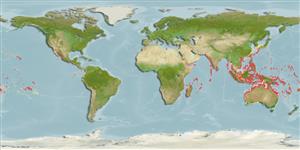Preferred temperature (Ref.
123201): 24.7 - 29, mean 27.8 °C (based on 1054 cells).
Phylogenetic diversity index (Ref.
82804): PD
50 = 0.7500 [Uniqueness, from 0.5 = low to 2.0 = high].
Bayesian length-weight: a=0.01023 (0.00477 - 0.02194), b=3.02 (2.84 - 3.20), in cm total length, based on LWR estimates for this (Sub)family-body shape (Ref.
93245).
Trophic level (Ref.
69278): 3.4 ±0.4 se; based on size and trophs of closest relatives
Widerstandsfähigkeit (Ref.
120179): hoch, Verdopplung der Population dauert weniger als 15 Monate. (Preliminary K or Fecundity.).
Fishing Vulnerability (Ref.
59153): Low vulnerability (10 of 100).
Nutrients (Ref.
124155): Calcium = 113 [61, 222] mg/100g; Iron = 0.791 [0.415, 1.434] mg/100g; Protein = 18.4 [16.5, 20.1] %; Omega3 = 0.15 [0.07, 0.26] g/100g; Selenium = 21.7 [12.0, 41.9] μg/100g; VitaminA = 140 [39, 428] μg/100g; Zinc = 1.93 [1.31, 2.82] mg/100g (wet weight);
